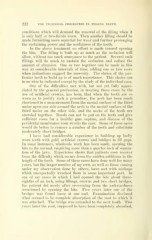Page 486 - My FlipBook
P. 486
222 THE TECHNICAL PKOCEDUEES IN FILLING TEETH.
conditions wliieli will demand tlie renewal of the filling when it
is only half or two-thirds worn. Then another filling should be
made furnishing more material for wear and further prolonging
the sustaining power and the usefulness of the tooth.
In the above treatment no effort is made toward opening
the bite. The filling is built up as much as the occlusion will
allow, without too much annoyance to the patient. Several such
fillings will do much to sustain the occlusion and reduce the
amount of abrasion. One or two together can be made in this
way at considerable intervals of time, adding one or two more
when indications suggest the necessitj'. The choice of the par-
ticular teeth to build up is of much importance. This choice can
in no wise be indicated except by the study of the individual case.
One of the difficulties met with, but not yet fully appre-
ciated by the general profession, in treating these cases by the
use of artificial crowns, has been, that when the teeth are so
worn as to justify such a procedure, the arch has been much
shortened in a measurement from the mesial surface of the third
molar upon one side around the arch to the mesial surface of the
third molar on the other side, and the necks of the teeth are
crowded together. Bands can not be put on the teeth and give
sufficient room for a healthy gum septum, and disease of the
peridental membranes soon wrecks the case. Some of these cases
would do better to remove a number of the teeth and substitute
moderately short bridges.
I have had considerable experience in building up badly
worn teeth with gold, artificial crowns and bridges to fill gaps.
In some instances, wholesale work has been made, opening the
bite to the normal, requiring more than a quarter-inch of separa-
tion of the jaws. Experience shows that patients soon recover
from the difficulty which occurs from the sudden additions to the
length of the teeth. Some of these cases have done well for many
years, but the larger number of my own, as well as those coming
under my observation done by others, have met with mishaps
which unexpectedly wrecked them in some important part. In
one of my cases in which I had opened the bite about three-
eighths of an inch, using fillings, crowns and two short bridges,
the patient did nicely after recovering from the awkwardness
occasioned by opening the bite. Five years later one of the
bridges was found loose at one end. Examination disclosed
what seemed to be complete absorption of the root to which it
was attached. The bridge was extended to the next tooth. Two
years later the root, sui)posed to have been completely absorbed,


